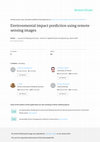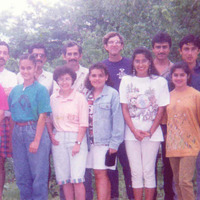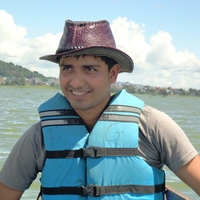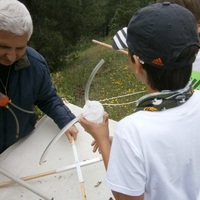Papers by Priyabrata Mohanta
Page 1. CHAPTER 4.4. USE OF GEOGRAPHIC INFORMATION SYSTEMS AND SPATIALANALYSIS IN AREA-WIDE INTEG... more Page 1. CHAPTER 4.4. USE OF GEOGRAPHIC INFORMATION SYSTEMS AND SPATIALANALYSIS IN AREA-WIDE INTEGRATED PEST MANAGEMENT PROGRAMMES THAT INTEGRATE THE STERILE INSECT TECHNIQUE J. ST. H. COX 1 AND MJB VREYSEN 2 ...

Journal of Zhejiang University Science, 2008
Environmental impact prediction is an important step in many environmental studies. A wide variet... more Environmental impact prediction is an important step in many environmental studies. A wide variety of methods have been developed in this concern. During this study, remote sensing images were used for environmental impact prediction in Robatkarim area, Iran, during the years of 2005~2007. It was assumed that environmental impact could be predicted using time series satellite imageries. Natural vegetation cover was chosen as a main environmental element and a case study. Environmental impacts of the regional development on natural vegetation of the area were investigated considering the changes occurred on the extent of natural vegetation cover and the amount of biomass. Vegetation data, land use and land cover classes (as activity factors) within several years were prepared using satellite images. The amount of biomass was measured by Soil-adjusted Vegetation Index (SAVI) and Normalized Difference Vegetation Index (NDVI) based on satellite images. The resulted biomass estimates were tested by the paired samples t-test method. No significant difference was observed between the average biomass of estimated and control samples at the 5% significance level. Finally, regression models were used for the environmental impacts prediction. All obtained regression models for prediction of impacts on natural vegetation cover show values over 0.9 for both correlation coefficient and R-squared. According to the resulted methodology, the prediction models of projects and plans impacts can also be developed for other environmental elements which may be derived using time series remote sensing images.
International Lakes which aim to strengthen national measures for the protection and ecologically... more International Lakes which aim to strengthen national measures for the protection and ecologically sound management of trans-boundary surface waters and groundwater and establish concrete procedural obligations of cooperation between littoral states. They also include provisions for monitoring, research and development, consultations, warning and alarm systems, mutual assistance, institutional arrangements, and exchange and protection of information, as well as public access to information.
Modern agriculture is influenced by both the pressure for increased productivity and increased st... more Modern agriculture is influenced by both the pressure for increased productivity and increased stresses caused by plant pests. Geographical Information Systems and Global Positioning Systems are currently being used for variable rate application of pesticides, herbicide and fertilizers in Precision Agriculture applications, but the comparatively lesser-used tools of Remote Sensing and Spatial Analyses can be of additional value in integrated

Water Resources Management, 2011
Remote sensing (RS) and geographic information system (GIS) are promising tools for efficient pla... more Remote sensing (RS) and geographic information system (GIS) are promising tools for efficient planning and management of vital groundwater resources, especially in data-scarce developing nations. In this study, a standard methodology is proposed to delineate groundwater potential zones using integrated RS, GIS and multi-criteria decision making (MCDM) techniques. The developed methodology is demonstrated by a case study in Udaipur district of Rajasthan, western India. Initially, ten thematic layers, viz., topographic elevation, land slope, geomorphology, geology, soil, pre-and post-monsoon groundwater depths, annual net recharge, annual rainfall, and proximity to surface water bodies were considered in this study. These thematic layers were scrutinized by principal component analysis technique to select influential layers for groundwater prospecting. Selected seven thematic layers and their features were assigned suitable weights on the Saaty's scale according to their relative importance in groundwater occurrence. The assigned weights of the thematic layers and their features were then normalized by using AHP (analytic hierarchy process) MCDM technique and eigenvector method. Finally, the selected thematic maps were integrated by weighted linear combination method in a GIS environment to generate a groundwater potential map. Thus, four groundwater potential zones were identified and demarcated in the study area, viz., 'good', 'moderate', 'poor' and 'very poor' based on groundwater potential index values. The area falling in the 'good' zone is about 2,113 km 2 (17% of the total study area), which encompasses major portions of Sarada,
International Planning Studies, 1997
Abstract The publication of the Brundtland Report in 1987 has led to worldwide concern over susta... more Abstract The publication of the Brundtland Report in 1987 has led to worldwide concern over sustainable development. Sustainable development is particularly important to regions that are undergoing rapid economic development, such as the Pearl River Delta and other ...











Uploads
Papers by Priyabrata Mohanta